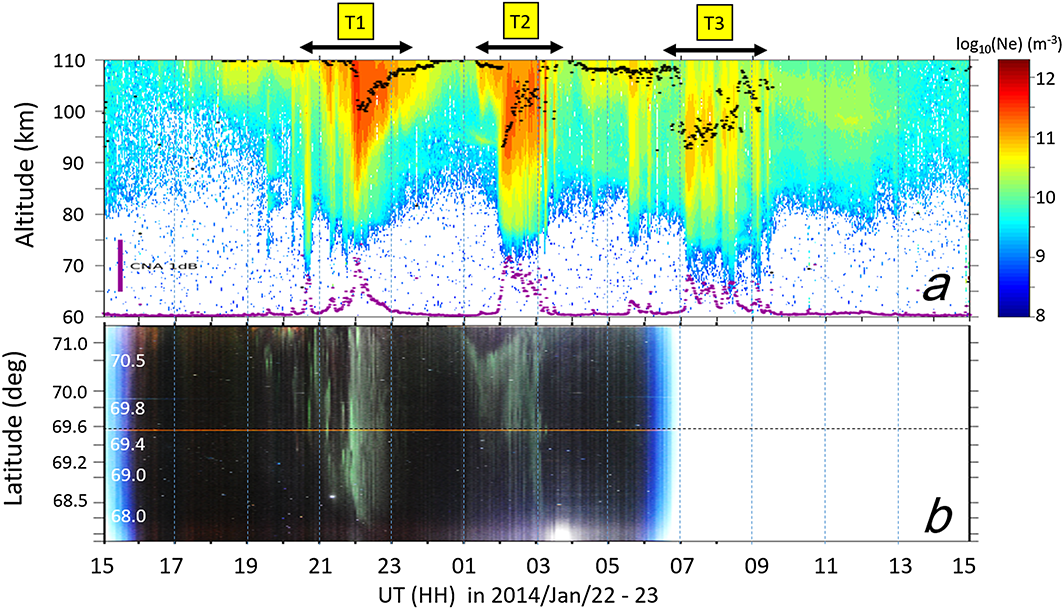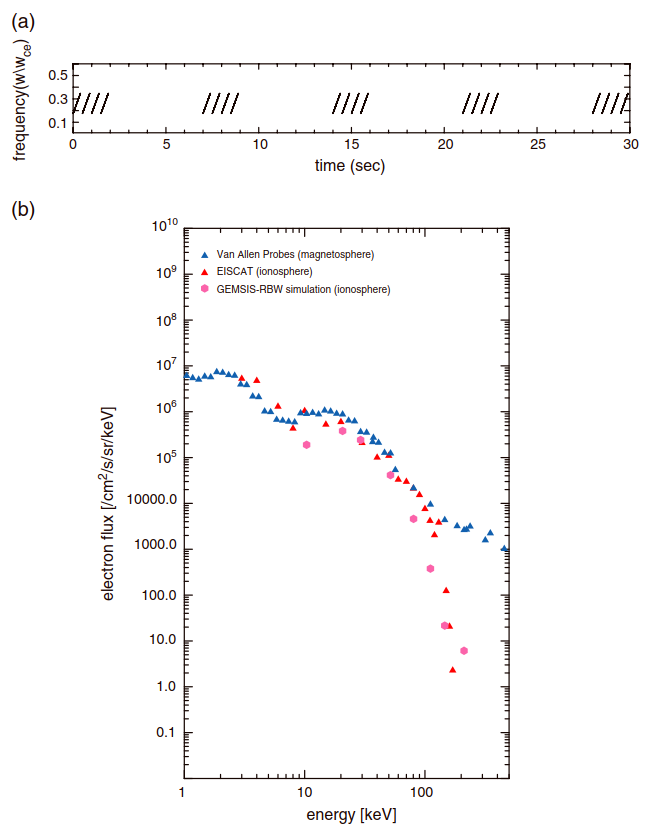Energetic electron precipitation and auroral morphology at the substorm recovery phase (Oyama et al., JGR, 2017)2017.7.16
(a) Electron density measured with the EISCAT VHF radar at 60-110 km height for 24 h from 15 UT in 22 January 2014. Black dots present a height where the electron density peaks during each integration period (1 min). Purple dots present CNA (dB) estimated from the EISCAT-measured electron density (a horizontal line of 60 km height corresponds to 0 dB for the CNA. Scale of 1 dB is marked in the figure). (b) Keogram made of an all-sky camera images taken from 15 to 07 UT in 22-23 January 2014 at the Tromso EISCAT radar site, which is marked by a horizontal red line. Three time intervals focused in this study are highlighted by yellow boxes and arrows at the top of Figure 1a.
It is well known that auroral patterns at the substorm recovery phase are characterized by diffuse or patch structures with intensity pulsation. According to satellite measurements and simulation studies, the precipitating electrons associated with these aurorae can reach or exceed energies of a few hundreds of keV through resonant wave-particle interactions in the magnetosphere. However, because of difficulty of simultaneous measurements, the dependency of energetic electron precipitation (EEP) on auroral morphological changes in the mesoscale has not been investigated to date. In order to study this dependency, we have analyzed data from the European Incoherent Scatter (EISCAT) radar, the Kilpisjärvi Atmospheric Imaging Receiver Array (KAIRA) riometer, collocated cameras, ground-based magnetometers, the Van Allen Probe satellites, Polar Operational Environmental Satellites (POES), and the Antarctic-Arctic Radiation-belt (Dynamic) Deposition-VLF Atmospheric Research Konsortium (AARDDVARK). Here we undertake a detailed examination of two case studies. The selected two events suggest that the highest energy of EEP on those days occurred with auroral patch formation from postmidnight to dawn, coinciding with the substorm onset at local midnight. Measurements of the EISCAT radar showed ionization as low as 65 km altitude, corresponding to EEP with energies of about 500 keV.
Oyama, S., A. Kero, C. J. Rodger, M. A. Clilverd, Y. Miyoshi, N. Partamies, E. Turunen, T. Raita, P. T. Verronen, and S. Saito (2017), Energetic electron precipitation and auroral morphology at the substorm recovery phase, J. Geophys. Res. Space Physics, 122, doi:10.1002/2016JA023484.
カテゴリ:M-I Coupling
Energetic electron precipitation associated with pulsating aurora: EISCAT and Van Allen Probe observations (Miyoshi et al., JGR, 2015)2017.2.18
Figure 8. (a) Frequency-time diagram of the LBC waves used in the GEMSIS-RBW simulation. (b) Energy spectrum at the magnetosphere observed by the Van Allen Probe-A satellite (blue triangle), at the ionosphere altitude estimated by the CARD inversion method using the EISCAT observation data (red triangle). Purple hexagons indicate the precipitated flux simulated by GEMSIS-RBW.
Pulsating auroras show quasi-periodic intensity modulations caused by the precipitation of energetic electrons of the order of tens of keV. It is expected theoretically that not only these electrons but also subrelativistic/relativistic electrons precipitate simultaneously into the ionosphere owing to whistler mode wave-particle interactions. The height-resolved electron density profile was observed with the European Incoherent Scatter (EISCAT) Tromsø VHF radar on 17 November 2012. Electron density enhancements were clearly identified at altitudes >68 km in association with the pulsating aurora, suggesting precipitation of electrons with a broadband energy range from ~10 keV up to at least 200 keV. The riometer and network of subionospheric radio wave observations also showed the energetic electron precipitations during this period. During this period, the footprint of the Van Allen Probe-A satellite was very close to Tromsø and the satellite observed rising tone emissions of the lower band chorus (LBC) waves near the equatorial plane. Considering the observed LBC waves and electrons, we conducted a computer simulation of the wave-particle interactions. This showed simultaneous precipitation of electrons at both tens of keV and a few hundred keV, which is consistent with the energy spectrum estimated by the inversion method using the EISCAT observations. This result revealed that electrons with a wide energy range simultaneously precipitate into the ionosphere in association with the pulsating aurora, providing the evidence that pulsating auroras are caused by whistler chorus waves. We suggest that scattering by propagating whistler simultaneously causes both the precipitations of subrelativistic electrons and the pulsating aurora.
Miyoshi, Y., S. Oyama, S. Saito, S. Kurita, H. Fujiwara, R. Kataoka, Y. Ebihara, C. Kletzing, G. Reeves, O. Santolik, M. Clilverd, C. J. Rodger, E. Turunen, and F. Tsuchiya (2015), Energetic electron precipitation associated with pulsating aurora: EISCAT and Van Allen Probe observations. J. Geophys. Res. Space Physics, 120, 2754–2766, doi: 10.1002/2014JA020690.
カテゴリ:Aurora,M-I Coupling


